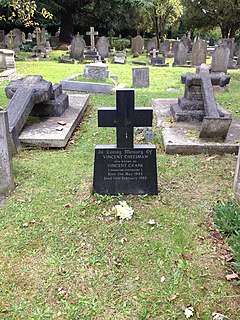Vincent Crane
Vincent Crane (born Vincent Rodney Cheesman; 21 May 1943 – 14 February 1989) was an English keyboardist who was best known as the organist for The Crazy World of Arthur Brown and Atomic Rooster. Crane co-wrote "Fire", the 1968 hit single by The Crazy World of Arthur Brown.
Vincent Crane | |
|---|---|
| Birth name | Vincent Rodney Cheesman |
| Born | 21 May 1943 Reading, Berkshire, England |
| Died | 14 February 1989 (aged 45) Westminster, London, England |
| Genres | Progressive rock, Hard rock, Blues rock, Psychedelic rock, Funk, rock |
| Instruments | Hammond organ, piano |
| Years active | 1967–1989 |
| Associated acts | Atomic Rooster, The Crazy World of Arthur Brown, Dexys Midnight Runners |
Career
Born Vincent Rodney Cheesman in Reading, Berkshire, he taught himself boogie woogie piano as a teenager before attending Trinity College of Music between 1961 and 1964.[1] Influenced by Graham Bond,[2] he took up Hammond organ. In late 1966 he formed the Vincent Crane Combo, which comprised bass player Binky McKenzie, sax player John Claydon and drummer Gordon Hadler. In 1967 he teamed up with Arthur Brown in The Crazy World of Arthur Brown. Their eponymous debut album, The Crazy World of Arthur Brown (1968) contained the song "Fire", co-written by Crane and a chart-topping hit single in the United Kingdom, the United States and Canada, with Crane's organ and brass arrangement to the fore.
During their first tour of the United States in 1968, Crane suffered a nervous breakdown and returned to the United Kingdom where he spent 3 or 4 months in the mental hospital at Banstead.[1] Crane rejoined the band but on a subsequent tour of the United States, the band disintegrated in June 1969 when Arthur Brown temporarily disappeared to a commune[1] and Crane and drummer Carl Palmer left to form Atomic Rooster,[3] playing their first concert at the Lyceum in London on 29 August headlining over Deep Purple.[1] Atomic Rooster enjoyed success in 1971 with two hit singles, "Tomorrow Night" and "Devil's Answer". Crane was the one constant member of the band through their almost constantly changing lineups, and wrote a slim majority of their material.
Atomic Rooster published their first eponymous album in 1970, and then drummer Carl Palmer left to form Emerson, Lake & Palmer that same year.
Crane suffered from bipolar disorder from at least 1968 onwards,[1] periodically necessitating treatment at both out- and inpatient mental health treatment facilities.[3]
He collaborated with other musicians on a number of albums, including Rory Gallagher (Rory Gallagher, 1971), Arthur Brown (Faster Than the Speed of Light, 1979), Peter Green, Richard Wahnfried, and Dexys Midnight Runners (Don't Stand Me Down, 1985). In 1983, he was part of the one-off blues outfit, Katmandu, with Ray Dorset, Len Surtees, and Peter Green, who recorded the album A Case for the Blues.
Crane died of a deliberate overdose of Anadin tablets in 1989 at age 45.[4]

Discography
Solo
- 1997: Taro Rota (with Arthur Brown)
The Crazy World of Arthur Brown
Atomic Rooster
- 1970: Atomic Roooster
- 1970: Death Walks Behind You
- 1971: In Hearing of Atomic Rooster
- 1972: Made in England
- 1973: Nice 'n' Greasy
- 1980: Atomic Rooster
- 1983: Headline News
with Arthur Brown
- 1979: Faster Than The Speed Of Light
References
- "colin-harper.com: Vincent Crane". colin-harper.com.
- Crane, Jeannie (August 2009). "A History Of Atomic Rooster". Jean Cheesman. Archived from the original on 6 June 2008. Retrieved 9 August 2009.
- Marshall, Polly. "The God Of Hellfire, the Crazy Life and Times of Arthur Brown". SAF Publishing. ISBN 0-946719-77-2.
- "Vincent Crane biography". angelfire.com. Retrieved 1 January 2011.
External links
- Atomic Rooster and Vincent Crane site, maintained by his widow Jeannie Crane and dedicated to his memory